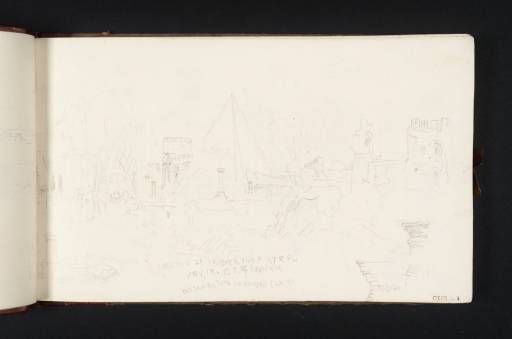Joseph Mallord William Turner Pyramid of Cestius, Rome, from the Protestant Cemetery 1819
Image 1 of 2
Joseph Mallord William Turner,
Pyramid of Cestius, Rome, from the Protestant Cemetery
1819
Joseph Mallord William Turner 1775–1851
Folio 9 Recto:
Pyramid of Cestius, Rome, from the Protestant Cemetery 1819
D16500
Turner Bequest CXCI 9
Turner Bequest CXCI 9
Pencil on white wove paper, 113 x 189 mm
Inscribed by the artist in pencil ‘C CESTIVS. LF PROB.ERVLO P RTR PL | VIIV IR. E P. V. LONVM | INSTAVRATVM ANDOM MDCLXIII’ bottom centre
Stamped in black ‘CXCI 9’ bottom right
Accepted by the nation as part of the Turner Bequest 1856
References
1909
A.J. Finberg, A Complete Inventory of the Drawings of the Turner Bequest, London 1909, vol.I, p.567, as ‘Pyramid of Cestius, &c., with St. Peter’s in distance’.
In an area to the south of the Aventine Hill and the east of Monte Testaccio in Rome lies the Protestant Cemetery (Cimiterio Accatolico), the burial ground of non-Catholics which would later become famous as the final resting place of British poets John Keats (1795–1821) and the heart of Percy Bysshe Shelley (1792–1822).1 This sketch, taken from the Protestant Cemetery, depicts the Pyramid of Cestius, a funerary monument of white marble which stands at the eastern end of the burial ground. Built between 18–12 BC for the magistrate Gaius Cestius Epulo, the pyramid was later incorporated into the Aurelian Walls and the Porta San Paolo, one tower of which can be seen beyond on the left.2 At the bottom of the page Turner has recorded two Latin inscriptions found on the eastern flank of the tomb. His transcription, however, is not entirely accurate. The texts should read ‘C. CESTIVS. L. F. POB. EPULO.PR.TR.PL.| VII.VIR.EPOLONVM’ [Caius Cestius Epulone, son of Lucius, of the tribe of Poblilia, praetor, tribune of the plebs, member of the College of the Septemviri Epulones],3 and ‘INSTAVRATVM.AN.DOMINI.MDCLXIII’ [Anno Domini 1663]. The latter commemorates excavation and restoration work carried out on the orders of Pope Alexander VII during the seventeenth century. In the bottom right-hand corner, are two detailed studies of the column base visible in front of the pyramid. On the far left-hand side of the page is a small part of the sketch from the opposite sheet, see folio 8 verso (D16449). There is also a separate view in the bottom left-hand corner of an unidentified landscape.
For other sketches of the Pyramid of Cestius see folios 6 verso (D16495) and the Albano, Nemi, Rome sketchbook (Tate D15374; Turner Bequest CLXXXII 42). As a young man, Turner had also made a study of the monument after another artist, see The Pyramid of Caius Cestius, Rome circa 1794–6 (Ashmolean Museum, Oxford). The drawing on this page later provided the compositional basis for a watercolour vignette, The Walls of Rome with the Tomb of Caius Sestus (Tate, N05242), engraved by Edward Finden as an illustration for The Life and Works of Lord Byron (published 1832–4).4 The design represented the title vignette to volume XIII of the publication and introduced Byron’s disturbing and unfinished play, The Deformed Transformed, several scenes of which are set against the backdrop of the walls of Rome.
Nicola Moorby
February 2009
Raymond Keaveney, Views of Rome from the Thomas Ashby Collection in the Vatican Library, exhibition catalogue, Smithsonian Institution, Washington 1988, p.208.
How to cite
Nicola Moorby, ‘Pyramid of Cestius, Rome, from the Protestant Cemetery 1819 by Joseph Mallord William Turner’, catalogue entry, February 2009, in David Blayney Brown (ed.), J.M.W. Turner: Sketchbooks, Drawings and Watercolours, Tate Research Publication, December 2012, https://www


